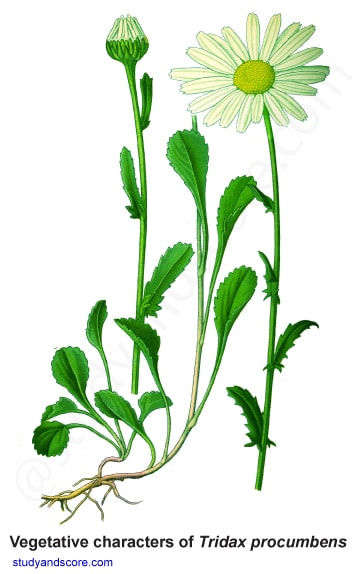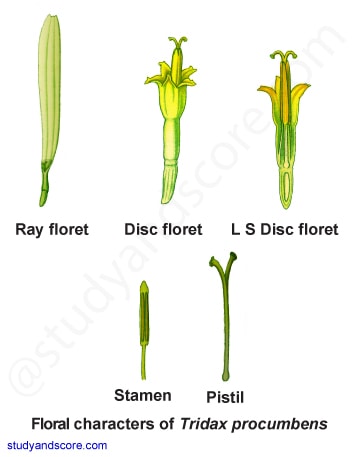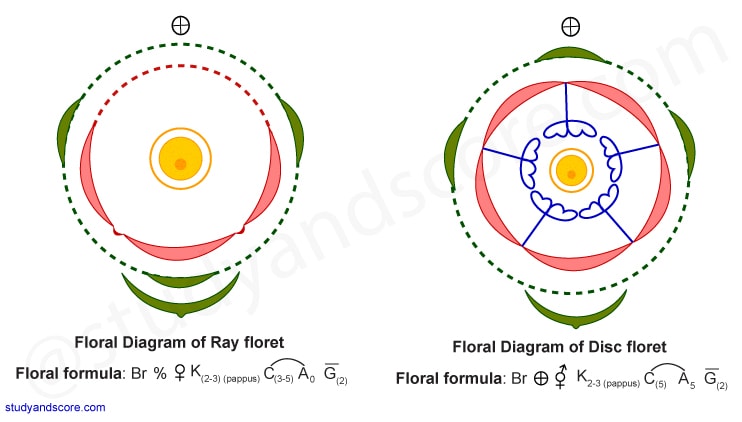Common name: Asteraceae, Compositae
Number of genera: Asteraceae is also known as Compositae. It is one of the largest families of flowering plants. This family includes 900 genera and about 13,000 species. These form more than ten per cent of the total number of species of flowering plants.
Propagation type: Seeds and fruits
Distribution: The members of this family are distributed throughout the world. They inhabit every conceivable situation. In India this family is represented by about 138 genera and 708 species. The members of this family are found chiefly in Himalayas and mountains of southern and western India.

Habitat: Members of this family are mostly mesophytes and some xerophytes are also known in this family.
Habit: Mostly annual or perennial herbs, rarely shrubs (Helianthus annus) and trees (Veronia). Occasionally marsh plants (Caesulia) also occur in this family.
Root system: Generally the root system is branched taproot system. Tuberous are present in Dhalia.The roots and stem may contain oil passages.
Stem: Herbaceous or woody, erect, branched. Helianthus tuberoses produces stem tubers. Many species have milky white sap. Stems are often covered by trichomes.
Leaf: Leaves are simple, alternate or opposite (Helianthus) or whorled (Eupatorium), exstipulate, petiolate, hairy, reticulate venation. They are simple or pinnately or palmately lobed. In Corymbium the leaves are parallel veined. Sometimes leaves are present in basal rosettes as in Taraxacum.

Inflorescence: The primary inflorescence is a racemose head or capitulum. It is terminal or axillary in position. In some species several heads aggregate to form compound head or umble or panicle. Each head is subtended by an involucre of green membranous bracts which are protective in function.
The flowers of this inflorescence are called florets. Number of florets in the head varies from few to many. Sometimes only single florets are present as in Echinopus. The flowers are open in acropetal succession. The florets are borne on a flat, concave or convex receptacle. Each floret is subtended by a receptacular bract called palea.
Flower: Flowers are bracteates, sessile, bisexual (sometimes unisexual or neutral), pentamerous, epigynous. The form of flowers may vary in head and the head may be homogamous or heterogamous.
Homogamous: All the florets are alike in structure and function. They are bisexual and either regular (Veronica) or liguate (Cichorium).
Heterogamous: Florets in heterogamous heads are of two types described below,
Disc florets
They are centripetally arranged complete florets. The florets are bracteate, actinomorphic and bisexual, tubular and epigynous. They do not possess any extra-appendage. So, this floret is illinguate
Calyx: Absent or modified into pappus
Corolla: Sepals 5 in number, Gamosepalous, tubular
Androecium: Stamens 2, epipetalous, syngenesious dithecous
Gynoecium: Bicarpellary, Syncarpous, unilocular, one ovule, on basal placentation style single, stigma bifid

Ray florets
They are peripherally placed incomplete florets. The florets are zygomorphic and unisexual or neutral. This helps in increasing the attraction of the flower. They possess extra appendages called ligule. So, this floret is ligulated.
Calyx: Absent or hairy pappus or scaly persistent
Corolla: Petals 5 in number, polypetalous, ligulate
Androecium: Absent
Gynoecium: Bicarpellary, syncarpous, unilocular, one ovule, the locule, basal placentation, style narrow and stigma branched, ovary inferior
Pollination: The success of this family lies in their adaptation to cross pollination. The plants of Asteraceae are cross pollinated by a variety of insects. Small flowers are made conspicuous by aggregation into heads. The flower heads are made more attractive by ray florets. A single visit of insect may pollinate large number of flowers. The nectar is secreted by a ring shaped disc found the base of the style. The nectar is in corolla tube. The corolla tube is easily accessible to all insects.
Cross pollination is promoted by protandrous condition of the Androecium. The narrow anthers are united to form a hollow cylinder to collect pollen. When the ovary is unripe, the style has two lobes very close to each other. In this condition, it emerges out through the tubular structure formed by the anthers. As it is emerging out, the hairs on the style brush the pollen out of the tube. After emergence, the branches of the style spread out to receive the pollen from another flower. If cross pollination fails, the branches of the style curve down to touches its own pollen and this brings about the self-pollination. In some species of Asteraceae self-pollination is a rule.
Fruit: The fruit is a Cypsela which is dispersed by pappus hairs (Taraxacum). In Xanthium the fruits are dispersed by animals due to presence of hooks.
Seed: Non-endospermic with straight embryo.
Family Asteraceae is also called as Compositae. This family has more than 900 genera and around 13000 species. The members of this family are distributed throughout the world. The following is a list of some important members of family Asteraceae, arranged alphabetically.
Ambrosia artemisiifollia (Rugweed)
Blumea balsamifera
Calendula officinalis
Carthamus tinctorius (Safflower)
Chrysanthemum cinerariaefolium
Chrysanthemum coccineum
Chrysanthemum marchallii
Cichorium intybus (Chicory)
Cynara scolymus (Globe Artichoke)
Helianthus annuus (Sun flower)
Helianthus tuberosus (Jerusalem Artichoke)
Lactuca saitva (Garden letuce)
Lactuca virosa
Spilanthes paniculata
Tagetes minuta (Stinking roger)
Tanacetum vulgare (Tansy)
Taraxacum officinale (Common dandelion)
Tragopogon porrifolium (Vegetable oyster)
Tussilago farfara (Coughwort)
The family Asteraceae contributes several food, dye, oil and medicine yielding plants. Also this family includes large number of ornamental plants.
Hope you have liked this post.
Please share it with your friends through below links.
All the very best from Team Studyandscore
“Study well, Score more…”
- Share with your friends! -
Login to post your comment here...
- or with social Account -